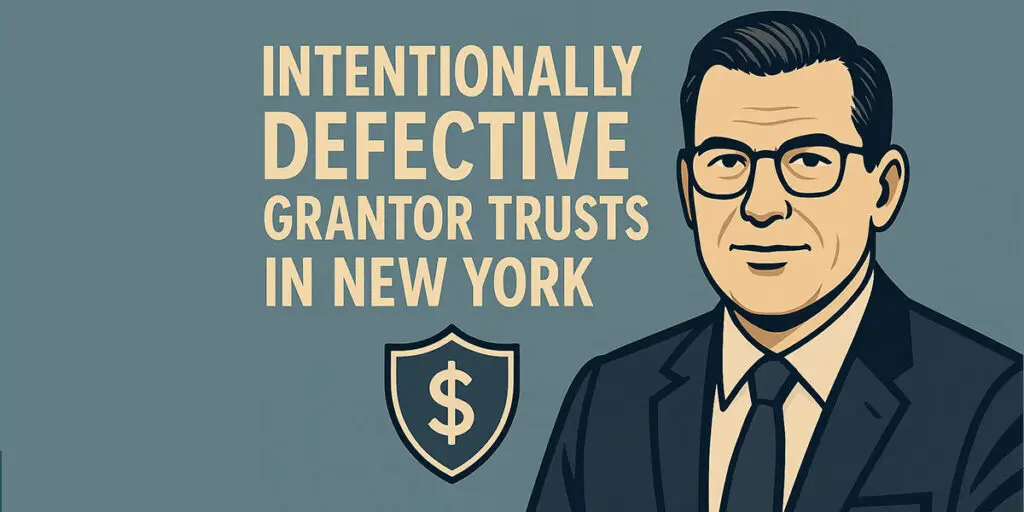Grantor Retained Annuity Trusts (GRATs) in New York: A Tax-Efficient Strategy for Wealth Transfer and Estate Planning
Minimizing estate taxes is a constant priority for high-net-worth individuals in New York. A Grantor Retained Annuity Trust (GRAT) is a sophisticated estate planning technique that can help you transfer assets to your beneficiaries while minimizing gift and estate taxes. GRATs are complex and require skill to form and administer. By strategically transferring assets to a GRAT, you can potentially “freeze” the value of those assets for estate tax purposes and shift future appreciation to your heirs tax-free. At Morgan Legal Group, serving New York City and beyond, we provide expert guidance on creating and managing GRATs to help our clients achieve their estate planning goals. This comprehensive guide will explore the key aspects of using GRATs in New York, providing valuable insights into their benefits, requirements, and how they can be integrated into your overall estate plan. Planning helps secure your hard-earned wealth.
What is a Grantor Retained Annuity Trust (GRAT)?
A Grantor Retained Annuity Trust (GRAT) is an irrevocable trust that allows you to transfer assets to your beneficiaries while minimizing gift and estate taxes. You, as the grantor, transfer assets to the trust and retain the right to receive a fixed annuity payment each year for a specified term. At the end of the term, the remaining assets in the trust pass to your beneficiaries. GRATs are designed for asset protection. Your attorney should be knowledgeable about both estate tax and New York laws.
Key features of a GRAT:
- Irrevocable: The trust cannot be easily changed or terminated once it is established.
- Fixed Annuity Payment: You receive a fixed annuity payment each year for a specified term.
- Transfer to Beneficiaries: At the end of the term, the remaining assets pass to your beneficiaries.
- Discounted Gift Tax Value: The transfer’s gift tax value is discounted based on the retained annuity interest and the IRS-prescribed interest rate (Section 7520 rate).
Understanding these elements is critical for effective GRAT planning. Careful attention is required. You should consult with an attorney about these various aspects.
Why Use a GRAT for Estate Tax Planning in New York?
GRATs offer a compelling way to transfer wealth to your beneficiaries while minimizing gift and estate taxes. A few benefits of using a GRAT are:
- Shifting Future Appreciation: Any appreciation of the assets in the GRAT during the term passes to your beneficiaries tax-free.
- Minimizing Gift Tax: The gift tax value of the transfer is discounted based on the retained annuity interest, potentially reducing or eliminating gift tax.
- Estate Tax Reduction: Assets held in a GRAT are removed from your taxable estate, potentially reducing estate taxes.
GRATs are particularly effective for assets that are expected to appreciate significantly in value during the term of the trust. The GRAT also minimizes any gift taxes. Proper use will provide you more wealth.
How Does a GRAT Work? A Step-by-Step Guide
Here’s a step-by-step guide to how a GRAT works:
- Establish the Trust: Work with an estate planning attorney to create a GRAT agreement.
- Transfer Assets to the Trust: Transfer assets, such as stocks, bonds, or real estate, to the GRAT.
- Retain an Annuity Interest: Retain the right to receive a fixed annuity payment each year for a specified term.
- Gift Tax Reporting: Report the transfer of assets to the GRAT on a gift tax return (Form 709).
- Asset Appreciation: If the assets in the GRAT appreciate in value during the term, that appreciation passes to your beneficiaries tax-free.
- Transfer to Beneficiaries: At the end of the term, the remaining assets in the GRAT pass to your beneficiaries.
The GRAT agreement must comply with IRS regulations to be effective. Compliance with the IRS regulations is paramount for realizing the tax savings. You must be thoughtful during the setup process.
Selecting Assets for Your GRAT: High-Growth Potential is Key
The assets you transfer to a GRAT should have the potential for significant appreciation during the term of the trust. Asset selection impacts the success of the GRAT.
Assets that are often used to fund GRATs:
- Publicly traded stock
- Privately held stock
- Real estate
- Intellectual property
- Other appreciating assets
Avoid transferring assets that are likely to depreciate or that have a low rate of return. High growth assets can maximize benefits. A financial advisor can help select appropriate assets. The goal is appreciation, so consult with your financial advisor for guidance on your options.
Choosing the GRAT Term: Balancing Tax Benefits and Mortality Risk
The term of the GRAT is a critical factor that can impact the tax benefits and your mortality risk. The ideal term length will depend on several factors.
When choosing a term, consider:
- Your age and health
- The expected rate of return on the assets
- The applicable IRS interest rate (Section 7520 rate)
Shorter-term GRATs are generally less risky, as there is less chance you will die before the end of the term. However, shorter-term GRATs may also result in lower tax savings. The balance requires professional insight. Long-term and short-term each have advantages.
Calculating the Annuity Payment: Maximizing Tax Efficiency
The annuity payment is the fixed amount you will receive each year during the term of the GRAT. The higher the annuity payment, the lower the gift tax value of the transfer. However, if the annuity payment is too high, it may deplete the trust assets and leave little or nothing for your beneficiaries at the end of the term. A balance must be met.
Careful calculation of the annuity payment is essential for maximizing tax efficiency and ensuring your beneficiaries receive a substantial benefit. Proper planning maximizes the tax savings. Get help from a qualified attorney.
Zeroing Out the GRAT: Minimizing Gift Tax Exposure
A “zeroed-out” GRAT is a GRAT that is structured to minimize the gift tax value of the transfer. This is achieved by setting the annuity payment high enough so that the present value of the retained annuity interest equals the value of the assets transferred to the trust. Zeroing out means minimizing exposure to a tax on what you give.
A zeroed-out GRAT can be a valuable strategy for transferring assets with minimal gift tax consequences. However, it’s important to note that the IRS may scrutinize zeroed-out GRATs closely. There are regulations in place that must be followed. This is where an attorney can provide you with the protection that is needed.
What Happens If You Die During the GRAT Term? Mortality Risk Considerations
One of the biggest risks associated with GRATs is the possibility of dying before the end of the term. If this happens, the assets in the GRAT will be included in your taxable estate, negating the tax benefits of the GRAT. As such, there is still that aspect of a gamble involved. Proper planning minimizes this risk.
To mitigate this risk, you can:
- Choose a shorter term for the GRAT
- “Ladder” GRATs by creating multiple GRATs with staggered terms
- Purchase life insurance to cover the potential estate tax liability
These steps will help you in the process and also let you keep more control. Planning is key to the safety. You always want to have a backup plan in place.
The Benefits of “Laddering” GRATs: Mitigating Mortality Risk and Increasing Flexibility
“Laddering” GRATs involves creating multiple GRATs with staggered terms. This strategy can help mitigate the risk of dying before the end of the term and also provide greater flexibility in managing your assets. This helps provide security and the best possible outcome.
With laddering GRATs:
- If you die before the end of the term of one GRAT, the other GRATs may still be successful in transferring assets to your beneficiaries tax-free.
- You can adjust the annuity payments on the new GRATs based on changes in interest rates or asset values.
Laddering provides a layered approach to risk management. This also increases security in your situation,
Combining a GRAT with a Life Insurance Trust: A Powerful Combination
Combining a GRAT with a Life Insurance Trust (ILIT) can be a powerful strategy for estate tax planning. The GRAT shifts the appreciation of assets out of your estate, and the ILIT provides funds to pay any estate taxes that may be due. This partnership is essential for you and for everyone.
The ILIT can:
- Hold a life insurance policy on your life
- Receive the life insurance proceeds upon your death
- Use the proceeds to pay estate taxes or to provide liquidity to your estate
Life insurance provides a financial backup in case of premature death. Expert counsel can assist you with this unique plan. Be proactive and ensure all is in order.
Working with an Experienced Estate Planning Attorney in New York
Creating and managing a GRAT involves complex legal and tax issues. It’s important to work with an experienced estate planning attorney who is knowledgeable about New York law and committed to providing personalized and effective legal services.
An attorney can help you:
- Evaluate whether a GRAT is right for you
- Structure the GRAT to maximize its tax benefits
- Transfer assets to the GRAT properly
- Comply with all applicable laws and regulations
Finding legal professionals will put your mind at ease. Consult with Morgan Legal Group to be sure your assets are protected.
Protecting Your Legacy with Morgan Legal Group
At Morgan Legal Group, we are dedicated to helping high-net-worth individuals and families in New York protect their legacy through effective GRAT planning. Our experienced attorneys have a deep understanding of estate tax law and are committed to providing personalized and effective legal services. Reach out and know you are in good hands. Contact us today to schedule a consultation and learn more about how we can help you achieve your estate planning goals. Find our Google My Business using this link and read about our amazing work.
Morgan Legal Group proudly serves the New York City community including the Bronx, Brooklyn, NYC, Queens, and Staten Island. If you are outside of New York City we also serve Long Island including Suffolk County. As well as Westchester, Ulster County, and Orange County.NY Courts







